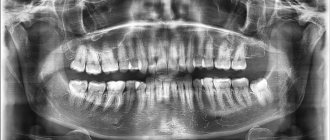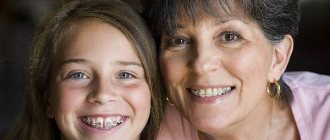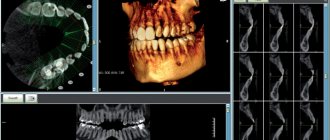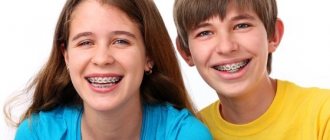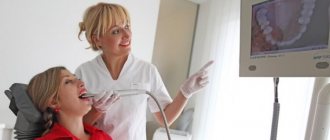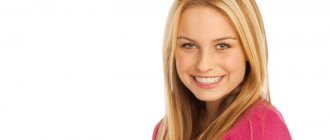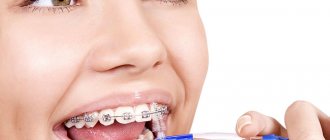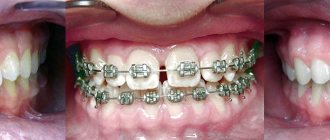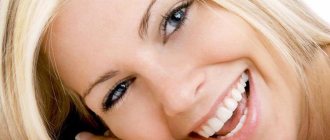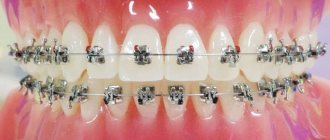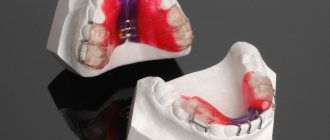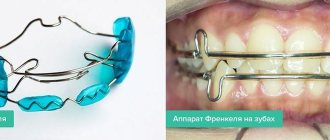In orthodontics, special masks are used, without which the correction of certain malocclusions is unthinkable, especially when it comes to mesial occlusion. A facial mask is a design for correcting bites with two supports in the chin and forehead area. There are different types and purposes of masks. In this article, we will tell you in detail about the functions and features of face masks.
Types and purpose
By type of design, masks are classified as extraoral orthodontic devices. Among the variety of similar products, several common devices used for bite correction can be identified:
- Dilyar mask;
- Petit mask;
- Tubunger mask.
Each face mask in orthodontics has its own characteristics, but in general they are based on the same principle of creating mesial and horizontal traction. The Dilyara apparatus is an indispensable device for the treatment of mesial occlusion. But at the same time, the indications for use indicate that with reverse incisal overlap, the width of the sagittal gap should not exceed 2 mm. And the permissible mesial displacement of the lower molars should be no more than 1 cusp.
Before deciding to use the device, the physiological characteristics of the patient are taken into account - the profile must be concave. Age is also taken into account, since the highest effectiveness is observed in primary and mixed dentition.
Wearing the Dilyar face mask does not cause any difficulties, which explains the popularity of its use for correcting malocclusion. For patients, wearing it is also associated with a certain comfort: the absence of intraoral orthodontic structures, ease of care of the device.
Delyar's face mask
MANUFACTURER: ORTHO TECHNOLOGY (USA)
Product information:
Delyar's face mask
- an extraoral orthodontic device and is named after its developer - the French orthodontist Delaire. The device is fixed on the face like a mask. The design is used to restrain the growth of the lower jaw and stretch the upper jaw.
It has two supports - on the forehead and on the chin or cheekbones. A thread is attached to the arch, which is located between the forehead and chin. The other end of the thread is fixed on one or more teeth that need correction. By stretching, it simultaneously fixes the mask on the face and straightens the teeth.
The duration of treatment is individual for each patient and is determined by the orthodontist. On average, you need to wear a mask for several months, making sure to remove it while you sleep, as it can cause microtrauma to the face.
It is comfortable to wear because it weighs no more than regular glasses and does not “overload” the face. Therefore, it is easy to get used to it, and if necessary, you can easily remove it.
Each structure performs a specific function - moving, holding back, extending, expanding or shaping the dentition. The choice of design primarily depends on the patient’s bite condition and the required degree of impact on the teeth and jaws.
Types of construction:
- universal mask with chin support;
- mask with cheek support;
- large or small vertical mask;
- horizontal mask large or small.
Advantages:
- the mucous membranes do not become inflamed, since there are no structures with sharp corners in the oral cavity;
- light weight, which makes wearing the mask very comfortable;
- ease of use: the mask is easily removed - you can easily brush your teeth and clean the orthodontic structure;
- high efficiency: the mask allows you to correct bite pathologies in a short time. In addition, it is convenient for the doctor to work with it when assessing the results of treatment.
Flaws:
- long period of treatment: the mask cannot be worn around the clock and this reduces its effectiveness;
- accuracy is required: when wearing a mask, you need to be careful and attentive so as not to break the structure or harm yourself with sharp elements;
- control is necessary: you must strictly adhere to the wearing regimen prescribed by the orthodontist, otherwise the mask will not be effective, but taking it off and putting it in a drawer is so tempting!
- psychological discomfort that may be caused by the not very aesthetic appearance of the mask.
Advantages
A face mask has many advantages, which explains the frequent use of such devices in orthodontics. Let's look at their positive qualities.
- There is only an easily removable thread in the oral cavity.
- The outer part is easily removed.
- The design is felt by the patient no more than glasses.
- The treatment gives good results.
Types of Face Protective Masks
Respirators
Respirators (go to products) are used primarily in industry or rescue activities: these are full-fledged PPE (go to catalog), either filtering air (passing it through a filter, so that the owner inhales already purified gas), or isolating (in such models, clean air is pumped into the mask via a hose, and there is no interaction of the respiratory organs with the potentially contaminated environment at all). The respirator can be equipped with a replaceable or built-in filter, and can be full-face (which also covers the eyes) or half-face (on the nose and chin).
By purpose they are divided into:
- anti-dust (anti-aerosol), protecting against dust, smoke, aerosols, but not against gases and vapors,
- gas protection, protects against organic and inorganic gases, does not allow odors to pass through,
- combined, universal PPE that protects against both gases and dust.
Respirators are used for military and medical purposes, in industry, they can also be used in everyday life, for example, during construction work when interacting with toxic materials, fine dust, and aerosol paint.
Anti-aerosol protective face masks
They are very popular as an analogue of a medical mask, although they are most in demand at construction sites, where they protect the respiratory system from fine dust and caustic paints. They fit much tighter to the face than a standard medical mask, and also have a valve for breathing.
Differ in degree of protection into:
- FFP1 for work in dusty rooms with non-toxic suspension, retains up to 80% of liquid and solid substances,
- FFP2 for work in rooms where substances of medium toxicity are sprayed, retains about 94% of harmful suspended matter,
- FFP3, the maximum degree of protection, which is also recommended by doctors for maximum protection against viruses. Stops up to 99% of harmful particles.
Like any other face-protective mask, an anti-aerosol mask must be changed regularly.
Upgraded medical masks
It differs from a regular mask in the large number of layers - usually six of them - and the presence of a breathing valve that removes moisture and prevents the mask from quickly getting wet (and therefore losing effectiveness). They often have an additional carbon filter, as well as a design that provides a tighter fit to the face.
The 2.5 PM mark indicates protection against fine particles. In everyday language, these are small particles of moisture and dust that are constantly in the air. If replaced in a timely manner, a modified medical mask will stop them.
Standard medical masks
Sold in pharmacies, they can be three-layer (these are called “procedural”) and four-layer (“surgical”). Medical masks are made from non-woven spunbond polymer material or its analogues, produced using the same technology, which retain moisture well - it is with moisture particles that most viruses are transmitted.
First of all, a medical mask protects other people from the wearer, so they are recommended for wearing by people with ARVI and those who suspect they have an asymptomatic contagious viral disease transmitted by airborne droplets. To a lesser extent, a mask protects the person wearing it, but still has the ability to trap viruses.
It is disposable and must be replaced every 2 hours or when it gets wet.
To protect yourself and others during a pandemic, you can wear an industrial respirator, but it is important to ensure that its filters are replaced in a timely manner, otherwise there will be no point in using it. However, for each RPE, the appropriateness is good - and medical masks, both standard and modernized, will protect against viruses quite well.
Operating principle and wearing rules
The design of the face mask is quite simple. Two soft pads are fixed in the forehead and chin area, between which there are vertical metal arches. An intraoral structure of arches, loops and hooks is attached to them. The tension created causes the displacement of individual teeth or the entire jaw at once.
If in childhood only a facebow is sufficient, then for the treatment of adolescents and adults it is used simultaneously with braces, mainly to correct the position of chewing lateral teeth. The wearing period of this design ranges from two to four months.
The exact timing is determined by the orthodontist in accordance with the severity of the bite pathology. Due to its appearance, it is not possible to wear this device all the time, so the duration is limited to 10-16 hours a day, which does not create additional difficulties for the patient.
Dilara face mask
Content
- Indications for use
- Operating principles and wearing rules
- Time to wear Dilyara face mask
- Advantages and disadvantages of the design
Dilyar's face mask belongs to the category of auxiliary extraoral orthodontic appliances, which are used to correct serious malocclusion pathologies without surgical intervention. The face mask is a removable design and can be used as an independent primary treatment or as an additional treatment simultaneously with installed braces.
Indications for use
- mesial bite, in which the lower jaw protrudes too far forward relative to the upper jaw,
- inhibition of growth of the lower or upper jaw,
- correction of the position of individual uneven chewing teeth,
- self-treatment for children and adults,
- treatment simultaneously with braces.
Dilara face mask: operating principles and wearing rules
The design of the device provides two supports with soft pillows - on the forehead, chin, and cheekbones. Between them there are vertical metal arcs. An intraoral structure is attached to them, which consists of one or more metal arches, as well as hooks or loops placed on the supporting teeth. Due to tension, the impact falls on some teeth or the entire jaw at once, which contributes to its displacement.
The best results are obtained by using the Dilyar mask to correct the bite in children with primary and mixed dentition. The mask uses horizontal traction, so it is very effective for correcting a lower jaw that is too forward.
However, its use is also justified in adolescence or adulthood with simultaneously installed braces for minor correction of the jaw position, and to a greater extent for correcting the position of the lateral chewing teeth.
Time to wear Dilyara face mask
The period of use of the Dilyar mask usually ranges from 2-4 months, but the specific period is determined by the orthodontist, taking into account the pathology of the bite and the need to influence the teeth and rows. It is impossible to wear the device all the time due to poor aesthetics, so the average number of hours per day is from 10 to 14-16. That is, you need to wear a mask while you sleep, as well as for several hours during the day.
Advantages and disadvantages of the design
Among the advantages of the device are sufficient comfort due to its low weight, soft fit to the face, and the absence of sharp metal corners in the intraoral part of the structure. In addition, the mask is easy to remove, simple to clean and allows you to effectively correct even the most serious malocclusion pathologies.
But the device also has disadvantages:
- poor aesthetics: the mask is an extraoral structure, so it is unlikely that you will be able to leave the house with it,
- long period of treatment: the mask cannot be worn constantly, which is why its effectiveness decreases, and the wearing period, on the contrary, increases,
- difficult to get used to: the design practically does not rub the mucous membranes, but discomfort will still arise due to the massiveness of the device,
- psychological stress: the mask is completely unaesthetic and the temptation to put it away in a drawer is very great. However, to get results, you need to fight with yourself and strictly follow the recommendations for using the device received from your doctor.
When brushing your teeth or eating food, the mask must be carefully removed. The device must be stored in a place where it will be protected from accidental damage. It is necessary to clean the device from bacteria with ordinary tap water, or with the addition of soap.
Also see:
FORSUS device
Lip bumper
Thank you! Your request will be processed within 12 hours.
Free consultation
Differences in masks by purpose
Masks are classified as active mechanical medical devices. They are classified by purpose and design features such as size, facial attachment points and appearance. There are several of the most common masks:
- universal purpose;
- with support on the cheeks;
- small and large vertical;
- small and large horizontal.
They all have their own application characteristics, but in general they are more often prescribed for primary or early mixed dentition. Recently, orthodontists quite often give preference to this method of treatment for children.
High efficiency and ease of use are the undoubted advantages of face masks. In the final video you can watch the installation of a mask in combination with another orthodontic design.
Dilyar mask: types of design
- universal mask with chin support,
- mask with support on the cheeks,
- large or small vertical mask,
- horizontal mask large or small.
Each structure performs a specific function - moving, holding back, extending, expanding or shaping the dentition. The choice of design primarily depends on the patient’s bite condition and the required degree of impact on the teeth and jaws.
